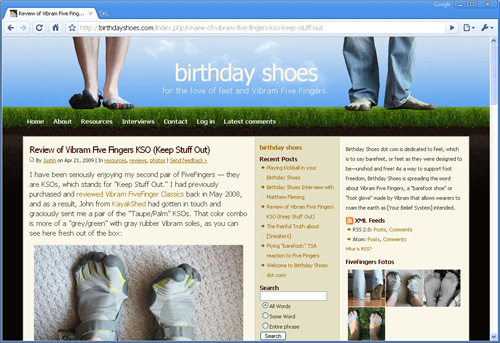As regular readers know, I have a pair of Vibram FiveFingers Classics (Reviewed last summer). I’ve gotten a lot of use out of my VFFs, having worn them for CrossFit, short runs, sprints, frisbee, world traveling, weight lifting, and for everyday uses like going to the grocery store or any number of other activities. Suffice to say that I think FiveFingers are a fantastic product and allow me the freedom of barefootedness.
So it was with great joy that I recently procured a pair of Five Finger KSOs via John at Kayak Shed, which I just reviewed yesterday. What’s that? You didn’t see my review? That’s because it’s not on justinowings.com. Rather, it is on my latest project, Birthday Shoes dot com, a site dedicated to being barefoot by way of consolidating information about the closest-thing-to-barefooted-footwear-available, Vibram FiveFingers:

Let me guess your thoughts. You think I’m out of my gourd to create a site about barefootedness, specifically one to support a product that is difficult to describe, a sock/shoe/foot-glove/ninja-shoe.
You might be right.
Five Fingers are just footwear: how great could this product be? Pretty extraordinary, actually. Why? Because they empower us modern hunter-gatherers to move about the earth and do things in accordance with our evolutionary design, which is to say, locomote a concrete, polluted and often trashy world wearing virtually nothing on our “birthday shoes” (Yeah, like “birthday suit!”) but a thin piece of rubber sole.
And though it might not be obvious at first glance, this is a very big deal. FiveFingers are important because they are designed to work harmoniously with our human nature. Sure, we all could entirely ditch any form of footwear, build up callouses on our feet, and roam the earth completely barefoot (Indeed, many do), but such a pure solution is also out of reach for most of us. By comparison, just as many pursue a “primal” or “paleo” diet by cutting out grains, sugar, heavily processed foods, and other modern food inventions, we still live in a modern world and aren’t hunting and gathering in a true sense, nor should we. There are fantastic benefits of modern technology; the trick is finding ways to marry our genetic hardwiring with our modern inventions.
FiveFingers go a long way towards that goal.
Birthday Shoes is an attempt to centralize information about Five Fingers, be a hub for different VFF experiences, display humans being human, barefooted or in their birthday shoes, and ultimately act as a sort of gateway-idea*, that can open the eyes of otherwise domesticated, corporate-dwelling, debt-servicing, and generally depressed people to a freer world, one more harmonious with our human nature.
In short, maybe I’m not that crazy after all, or at least, there is a method behind my madness. Check it out:
birthday shoes dot com
Recent posts at birthdayshoes.com:
- Review of Vibram Five Fingers KSO (Keep Stuff Out)
- Birthday Shoes Interview with Matthew Fleming
- The Painful Truth about [Sneakers]
- Flying “barefoot:” TSA reaction to Five Fingers
- Playing Kickball in your Birthday Shoes
* I’ve also called it a “trojan horse idea.” I can’t decide which way to describe VFFs is catchier. “Trojan horse” is kinda fun because the VFF is literally not unlike a mask or cover-up for our feet, hiding the reality of what is really going on. “Gateway idea” is nice because it uses the “gateway drug” definition — VFFs serve as a gateway or catalyst towards higher understanding about other things. Ah maybe I should just use both.